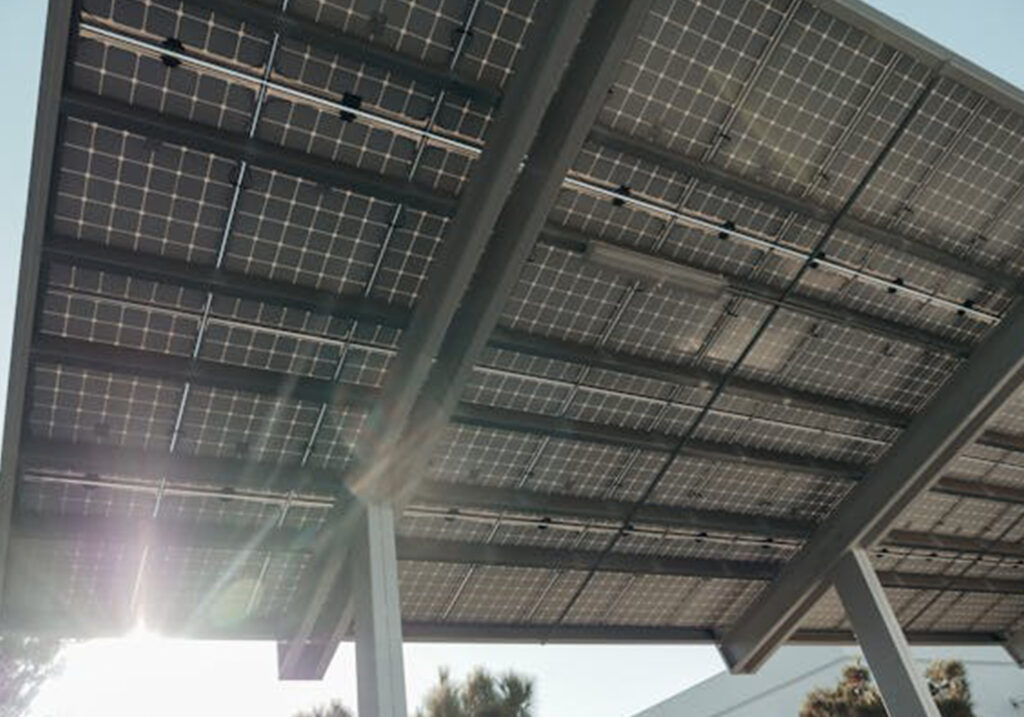Homeowners continually seek ways to enhance their property all the time. One such endeavor gaining traction is the transformation of open carports into enclosed garages.
This conversion not only offers protection for vehicles but also adds value and versatility to the property. This guide delves into the myriad aspects of enclosing a carport, providing insights into benefits, planning, costs, and considerations to ensure a successful transformation.
This article by the experts at Lion Carports will guide you through enclosing your carport.
Benefits of Enclosing a Carport
Enclosing a carport offers more than just enhanced vehicle protection. While it effectively shields your car from harsh sunlight, heavy rain, snow, and debris, it also secures any belongings stored within. Items such as tools, bicycles, lawn equipment, and recreational gear remain safe from environmental wear and tear. The added layer of security also deters theft and vandalism, which is particularly beneficial in neighborhoods where open spaces may attract unwanted attention.
Another key benefit is the increase in property value. Many potential buyers consider a fully enclosed garage a significant asset. A carport-to-garage conversion can improve curb appeal and contribute to the overall perception of a well-maintained and thoughtfully upgraded home. When executed properly, this improvement can offer a strong return on investment by making the property more desirable in a competitive real estate market.
The versatility of an enclosed garage cannot be overstated. While its primary function may be to store vehicles, it can easily double as a workshop, hobby room, home gym, or extra storage area. In some cases, homeowners have even converted part of the space into a home office or guest room. The adaptability of this space allows it to meet changing lifestyle needs without requiring a major home renovation.
Planning the Conversion
Thorough planning is essential before beginning the carport conversion process. The first step is to assess the structural integrity of the existing carport. A well-built carport with a solid foundation and roof will make the conversion smoother, whereas an older or less stable structure may need significant reinforcements. Bringing in a structural engineer or experienced contractor at this stage can provide a professional assessment and recommend necessary upgrades or design alterations.
Understanding and complying with local building codes is a critical part of the planning phase. Most municipalities require permits for structural modifications, and failure to obtain them can lead to legal or financial complications down the road. Permits help ensure that the new structure meets safety standards, zoning laws, and energy efficiency requirements. This step also helps protect your investment and makes future resale smoother, as any unpermitted work can delay or derail real estate transactions.
Aesthetic and functional design considerations also come into play. The new garage should blend seamlessly with the existing home architecture in terms of materials, color scheme, and roofline. This cohesion not only enhances the visual appeal but also supports property value. Functional aspects like insulation, lighting, and access points must also be incorporated into the design to ensure the space is comfortable and usable year-round.
Cost Considerations
The cost to enclose a carport can vary widely depending on several factors, including size, materials used, labor costs, and the level of customization. On average, a standard carport-to-garage conversion ranges between $10,000 and $30,000. This price typically covers framing, walls, insulation, a garage door, and basic electrical work. High-end features such as custom cabinetry, upgraded flooring, or climate control can significantly increase the final cost.
Homeowners should be prepared for potential hidden costs that may arise during the project. Structural reinforcements, water drainage solutions, foundation upgrades, and electrical panel updates are all common areas where additional expenses may occur. To avoid financial surprises, it’s advisable to include a contingency of 10 to 20 percent of the project cost in the budget. This buffer can help cover unexpected developments without halting progress.
Gathering multiple quotes from licensed contractors is an important part of managing the budget effectively. It allows homeowners to compare pricing, review proposed timelines, and understand the scope of work each contractor includes. Some homeowners might consider a partial DIY approach to save on labor, but this requires a solid understanding of construction and local codes. For most, hiring experienced professionals ensures the project is completed safely, efficiently, and in line with legal requirements.
Design and Material Selection
Selecting the right materials for enclosing a carport is crucial to achieving both long-term durability and visual appeal. Materials commonly used include wood, metal, and vinyl siding, each offering unique advantages. Wood provides a classic and warm appearance but may require regular upkeep such as staining or sealing. Metal siding is known for its strength and resistance to the elements, making it a popular choice for those seeking low-maintenance durability. Vinyl siding offers a versatile, affordable option that resists fading and moisture. The decision should take into account the climate of the region, the homeowner’s maintenance preferences, and the aesthetic harmony with the main house.
Insulation is another essential component, especially when the garage is intended for more than just vehicle storage. Proper insulation helps regulate temperature, prevent condensation, and reduce energy consumption. This is especially important if the enclosed space will be used as a workshop, studio, or home office. Choices range from fiberglass batt insulation to spray foam, each with different levels of effectiveness and cost. Soundproofing might also be considered if the space will serve as a recreational room or workspace.
Incorporating elements such as windows and doors adds functionality and beauty to the design. Windows can flood the interior with natural light, improving visibility and creating a more welcoming atmosphere. Choosing a garage door that matches the architectural style of the home contributes to a unified and pleasing exterior. Garage doors come in various materials and styles, including carriage house, traditional raised panel, and contemporary designs. Consulting with architects or design professionals ensures that all elements—from color schemes to finishing details—work together cohesively to meet both functional and stylistic goals.
Construction Process
The construction process for enclosing a carport involves a methodical sequence of steps, beginning with evaluating and reinforcing the existing structure. The original carport must be able to support the new load imposed by added walls, roofing, and possibly attic space. Reinforcement may include upgrading the foundation, installing additional support beams, or replacing older posts and joints. After the structural integrity is ensured, framing for walls and windows begins, followed by the installation of insulation, sheathing, and exterior siding.
Electrical work is a significant part of this phase, particularly if the space will have lighting, outlets, or climate control features. A licensed electrician should install wiring that meets code requirements and accommodates planned usage. Lighting fixtures, heating or cooling systems, and security features such as cameras or motion detectors are often added at this stage. Once electrical and insulation tasks are complete, finishing touches such as drywall, painting, flooring, and trim bring the interior space to life.
Maintaining consistent communication with the contractors is key throughout the construction phase. Regular walkthroughs and inspections allow homeowners to monitor progress and catch any discrepancies early. This helps avoid costly changes later on. Transparent communication helps ensure that materials are being used as planned, timelines are met, and safety protocols are followed. When professionals are involved from start to finish, the result is typically a garage conversion that aligns closely with the homeowner’s expectations and complies with all local building codes.
Potential Challenges
Converting a carport into an enclosed garage can introduce unexpected challenges that vary based on the age and condition of the original structure. Some carports may lack the necessary foundation depth or width to support new construction. In such cases, reinforcing or completely rebuilding the foundation becomes necessary. Older carports might also use materials or techniques that do not meet current safety codes, requiring updates to framing, roofing, or supports before proceeding with the enclosure.
Zoning regulations and neighborhood ordinances can also pose obstacles. Local rules may restrict how close structures can be to property lines, the total square footage of additional enclosed space, or the type of modifications allowed on certain properties. Failure to comply with these regulations can result in fines or demands to reverse the work. Working with professionals familiar with local codes can streamline the permitting process and reduce delays caused by red tape or misunderstandings.
Another common challenge is managing water drainage and indoor climate. Enclosing a carport changes airflow and insulation dynamics, which can lead to condensation, mold, or mildew if not properly addressed. Ventilation must be integrated into the design to maintain air circulation and prevent moisture buildup. Properly sloped roofs and gutters are also critical to channeling water away from the structure. Anticipating these issues during the planning phase helps prevent long-term maintenance problems and ensures the new space remains comfortable and functional year-round.
Maximizing the Space
Once the carport is successfully converted, the newly enclosed garage opens up a wide range of functional possibilities. In addition to serving as secure vehicle storage, it can be used as a home workshop for DIY projects or carpentry. Many homeowners also transform the space into a fitness area equipped with weights, mats, and machines. The enclosed environment offers privacy and protection, allowing users to focus on their tasks or hobbies without the interruptions common in open spaces.
To enhance functionality, incorporating built-in storage options such as shelving units, pegboards, and cabinets helps keep the area organized. Proper lighting, both natural and artificial, improves visibility and makes the space more inviting for different uses. For those looking to create a hybrid garage that serves multiple purposes, movable partitions or modular furniture can divide the space efficiently. This flexibility allows homeowners to adapt the garage to evolving needs without extensive remodeling.
Personalizing the enclosed garage is an opportunity to align it with the homeowner’s lifestyle and preferences. Some may choose to create a music studio, a crafting nook, or a quiet reading room. Others might opt for a minimalist design that focuses solely on clean lines and maximum utility. Regardless of the intended use, thoughtful design and layout planning can maximize every square foot. A well-designed garage not only enhances daily living but also adds emotional and practical value to the home.
Conclusion
Enclosing a carport is a transformative project that offers numerous benefits, from enhanced security and increased property value to versatile space utilization. Through careful planning, informed decision-making, and collaboration with professionals, homeowners can successfully convert their carports into functional and aesthetically pleasing garages. This investment not only elevates the property’s appeal but also enriches the homeowner’s living experience.

